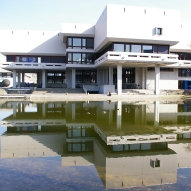| Dokumentenart: | Artikel | ||||
|---|---|---|---|---|---|
| Titel eines Journals oder einer Zeitschrift: | Clinical Hemorheology and Microcirculation | ||||
| Verlag: | IOS PRESS | ||||
| Ort der Veröffentlichung: | AMSTERDAM | ||||
| Band: | 70 | ||||
| Nummer des Zeitschriftenheftes oder des Kapitels: | 1 | ||||
| Seitenbereich: | S. 1-13 | ||||
| Datum: | 2018 | ||||
| Institutionen: | Medizin > Lehrstuhl für Chirurgie Medizin > Lehrstuhl für Mund-, Kiefer- und Gesichtschirurgie | ||||
| Identifikationsnummer: |
| ||||
| Stichwörter / Keywords: | SPINAL ACCESSORY NERVE; MASSETERIC NERVE; MOTOR-NERVE; SURGICAL ANATOMY; REANIMATION; ANASTOMOSIS; SURGERY; ORGANIZATION; SMILE; FACE; Facial nerve; zygomatic nerve branches; buccal nerve branches; facial paralysis; facial reanimation; facial anatomy; facial muscles; mimetic muscles; nerve transfer; cross-face-nerve grafts (CFNG); free muscle transplantation | ||||
| Dewey-Dezimal-Klassifikation: | 600 Technik, Medizin, angewandte Wissenschaften > 610 Medizin | ||||
| Status: | Veröffentlicht | ||||
| Begutachtet: | Ja, diese Version wurde begutachtet | ||||
| An der Universität Regensburg entstanden: | Ja | ||||
| Dokumenten-ID: | 47635 |
 Web of Science
Web of ScienceZusammenfassung
BACKGROUND AND OBJECTIVES: Early persistent facial paralysis is characterized by intact muscles of facial expression through maintained perfusion but lacking nerve supply. In facial reanimation procedures aiming at restoration of facial tone and dynamics, neurotization through a donor nerve is performed. Critical for reanimating target muscles is axonal capacity of both donor and recipient ...

Zusammenfassung
BACKGROUND AND OBJECTIVES: Early persistent facial paralysis is characterized by intact muscles of facial expression through maintained perfusion but lacking nerve supply. In facial reanimation procedures aiming at restoration of facial tone and dynamics, neurotization through a donor nerve is performed. Critical for reanimating target muscles is axonal capacity of both donor and recipient nerves. In cases of complete paralysis, the proximal stump of the extratemporal facial nerve trunk may be selected as a recipient site for coaptation. To further clarify the histological basis of this facial reanimation procedure we conducted a human cadaver study examining macro and micro anatomical features of the facial nerve trunk including its axonal capacity in human cadavers. Axonal loads, morphology and morbidity of different donor nerves are discussed reviewing literature in context of nerve transfers. METHODS: From 6/2015 to 9/2016 in a group of 53 fresh frozen cadavers a total of 106 facial halves were dissected. Biopsies of the extratemporal facial nerve trunk (FN) were obtained at 1 cm distal to the stylomastoid foramen. After histological processing and digitalization of 99 specimens available, 97 were selected eligible for fascicle counts and 87 fulfilled quality criteria for a semi-automated computer-based axon quantification software using ImageJ/Fiji. RESULTS: An average of 3.82 fascicles (range, 1 to 9) were noted (n = 97). 6684 +/- 1884 axons (range, 2655-12457) were counted for the entire group (n = 87). Right facial halves showed 6364 +/- 1904 axons (n = 43). Left facial halves demonstrated 6996 +/- 1833 axons (n = 44) with no significant difference (p = 0.73). Female cadavers featured 6247 +/- 2230 (n = 22), male showed 6769 +/- 1809 axons (n= 40). No statistical difference was seen between genders (p = 0.59). A comparison with different studies in literature is made. The nerve diameter in 82 of our specimens could be measured at 1933 +/- 424 mu m (range, 975 to 3012). CONCLUSIONS: No donor nerve has been described to match axonal load or fascicle number of the extratemporal facial nerve main trunk. However, the masseteric nerve may be coapted for neurotization of facial muscles with a low complication rate and good clinical outcomes. Nerve transfer is indicated from 6 months after onset of facial paralysis if no recovery of facial nerve function is seen.
Metadaten zuletzt geändert: 27 Aug 2021 08:44



 Altmetric
Altmetric